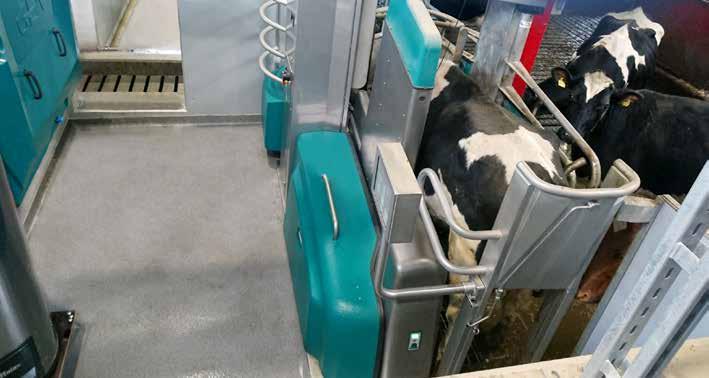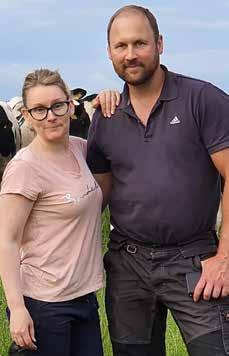
8 minute read
The real benefits of deploying tech in the Agri-Industry
The real benefits of deploying tech in the Agricultural Industry
All our daily activities are related to a technological process. The benefit of this science is very significant for humanity. After the industrial revolution, scientific knowledge has had an unstoppable growth, allowing machinery and innovation to make our lives much more manageable.
Advertisement
The goal of tech is to increase production, meet people’s needs, and improve the lives of humans. The agricultural industry has had a fantastic turnaround. This practice continues to be successful in many countries, even in pandemic and lockdown contexts.
A study from The Print found that agriculture grew by 3 percent in India during Covid-19 and will continue in that path in 2021. This industry generates food for millions of people around the world. It is one of the leading food and raw material producers for many companies. In the 21st century, the growth and good performance of agriculture are due not only to manual work but also to technological innovation. This article will review how the tech industry works as a team with agriculture and the trends for 2021 in this area.
Data for Agriculture
Private investment is an indispensable part of the search for an efficient agricultural system. Ag-Tech Startups are revolutionizing this industry forever. For several years the development of

these companies has positively impacted food production, especially with data processing. One of these companies is AGERpoint. This startup works with a satellite system that manages citrus and nut orchards. The software collects data on what trees can look like, their sizes, and the dimensions of the trunk.
A Forbes report revealed that this company had an estimated growth margin of $3 million in sales for 2017, a trend that would continue for many years. In addition to these proposals, it is interesting to analyze how the data science market is growing around the world. More and more people and companies request these services to solve problems.
Robotic Agriculture
Automation is not just a topic in car or computer factories. In agriculture, this trend receives much more attention than before. You may think agriculture is about people planting and harvesting fruits and vegetables, plowing the land, and watering the plants, yet robots are taking over these spaces as well.
“Smart Agriculture” is a tech industry strategy to produce more food using the fewest possible resources. This trend includes autonomous machinery, irrigation drones, harvesting robots, automatic irrigation, sowing equipment, and much more.
Greenhouses 2.0
Although greenhouses were created for educational and botanical purposes, they have been included in the agricultural industry little by little. This system has excellent support from the tech industry to offer better results in food production. These fields are part of providing fruits and vegetables in the cities since urban centers need to buy these foods due to the lack of space for planting.
Can this be a solution for healthy city food? The investment of greenhouses 2.0 means that cities and places where vegetable production is scarce will have much cheaper access. These new greenhouse systems have digital monitoring, LED lighting technology, automatic irrigation, and thermostat systems that regulate the temperature according to the type of plant.
Drip Irrigation
Is it possible to grow food in a desert? Tech companies in Israel have used all their potential and intelligence to develop innovative plans for cultivation. One of the most noteworthy ideas of recent times was the drip irrigation system.
The Polish-Israeli firm Simcha Blass created a sustainable method that consists of a pipe that sprinkles drops of water directly to the plants’ roots.
Although the idea began in 1960, its success has spread to more than 100 countries. One of this process’s main benefits is that evaporation is reduced between 15 and 30 percent, which benefits agriculture in arid climates, where the sun’s rays are powerful. This represents a better relationship between water and air, allowing the plants to flourish strongly. Drip irrigation is part of an initiative to grow food in poor, arid countries.
Conclusion:
The tech industry is an ally for everything we do. We all know that hunger and poverty are problematic issues. However, these proposals allow us to dream of a much better future. We can all eat healthy food and produce agricultural goods efficiently, without destroying the planet.

Sustainable milk production goes hand in hand with animal welfare and high quality

When it comes to modernization, Staffan Bäcketoft’s focus isn’t only on his business interests, but on the health and welfare of his 200 or so dairy cows as well. Together with his wife Martina, he runs an organic dairy operation called the Bäckeby Farm located outside the town of Målilla in the southern Swedish province of Kalmar. In order to increase labor efficiency as well as improving the lives and the health of his animals, Bäcketoft decided to switch from conventional to automated milking. At the same time, an automated feeding system from GEA would optimize the animals’ feed supply.
Bäcketoft’s modernization project has been granted financial support through the European Agricultural Fund. Within EU member states and regions, this fund fosters development in rural areas to strengthen market competitiveness in the agricultural sector, to ensure the sustainable use of natural resources and climate protection as well as to promote rural communities, including the creation of employment opportunities. Time savings by switching to automated milking Their good experiences with GEA’s herringbone milking parlor led the farm owners to choose GEA’s DairyRobot R9500 as the ideal next step in modernizing their farm’s milking technology. The switch also promised great advantages from a structural standpoint, as extending the front of the barn by only a few meters would suffice to accommodate the new milking center.

Today, however, Bäcketoft sees the greatest benefit in saved time that he can invest in important animal care instead of spending many hours a day milking conventionally. His day begins with a glance at all the information generated by the three automated milking boxes around the clock.
In particular, the milk alarms notify him of marked changes in milk quantity, conductivity or milk temperature in any cow down to the quarter level. Since deviating values can indicate disease onset in an animal, Bäcketoft can then take a look at
the reported cows directly in the barn and decide which measures need to be taken.
Early warning system for better animal health
Thanks to the DairyRobot’s timely and precise alerts, Bäcketoft can now treat his animals quickly in a targeted way preventing slumps in yield and reducing disease progression. Best proof of the herd’s improved constitution is the cell count numbers which dropped from 250,000 to 140,000. The cows’ good health pays off immediately: their milk commands a higher price at the dairy.
Peaceful atmosphere in the barn and independent milking
While cows previously had to be fetched for fixed milking times, now every animal in the barn goes to the spacious milking robot independently and waits until the wide gate opens. Via a responder, the milking robot checks if the cow is ready to be milked. Subsequently the MilkRack moves into position, and then attaches the teat cups.
With GEA’s DairyRobot, milking is carried out peacefully according to the In-Liner Everything principle. From stimulating to cleaning all the way to emptying the udder, the whole milking routine takes place in the protected environment of the teat cup. Finally, a dipping fluid is applied carefully and dosed optimally to each teat. This protects the teat’s sensitive skin and the stillopen teat canal from germs and bacteria for the next hours in the barn.
Fresh feed for animals of any rank
In the past, Staffan und Martina Bäcketoft noticed that milk yield fluctuated excessively. They attributed this to the unmonitored feed preparation, which was managed by three people using a feed mixer wagon. By installing the GEA MixFeeder, they optimized consistency and continuity in supplying feed to the herd. On rails, the feed wagon moves almost silently and brings fresh feed rations automatically according to a fixed time plan around the clock.
According to their own rhythm, the cows come to the feeding fence allowing even lower-ranked cows regular access to fresh feed mixtures. The MixFeeder also mixes the ingredients better. The cows eat what they are served without sorting out certain components and leave less feed behind at the end of the day.
Record milking yields
In the new feed kitchen that was attached to one side of the barn, the MixFeeder measures the feed ingredients independently via three bunkers and screw feeders and mixes them according to the farmers’ recipes into feed rations for the various performance groups. A good supply of fresh feed also means that the animals make better nutritional use of their fodder. This is directly reflected in strongly increased milk yield. The Bäckeby Farm is the first Scandinavian dairy farm with three automated GEA milking boxes and was able to increase the milk quantity to over 2,000 kg per box, which is a record result.

Stress-free farm life at a relaxed pace
Modernizing production has fundamentally improved life, working conditions and animal welfare at the Bäckeby Farm. Thanks to the insights provided by GEA’s DairyRobot, Bäcketoft now knows each of his dairy cows much better than before. Life in the barn is calm and relaxed, the animals eat, rest and move around according to their own rhythm and go to be milked without stress. Physically demanding, fixed milking times are a thing of the past and the two and a half hours previously needed for feeding have been reduced to a half hour per day spent filling up the bunkers and cleaning the feed kitchen.
The bottom line: great energy efficiency
With the GEA DairyRobot, up to three milking boxes can be run simultaneously with one control unit. The automated milking system is not only perfectly adapted to the Bäckeby Farm’s herd size, but the three milking boxes are economical and highly energy efficient. The largest gain in terms of energy was won by switching to the automated GEA MixFeeder. Getting rid of the old diesel-run feed mixer wagon means savings of up to 8,000 liters in fuel.
The Bäcketofts have not only made their farm more sustainable through modernization, but have also prepared themselves for a healthy and profitable future.











